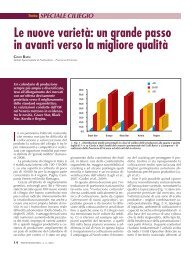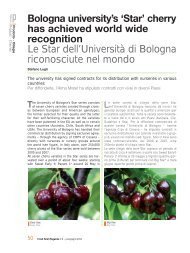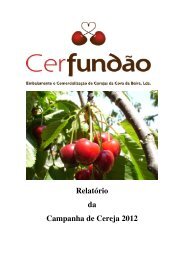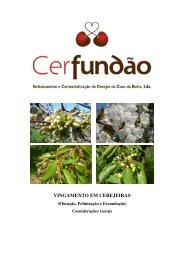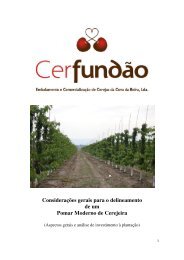Create successful ePaper yourself
Turn your PDF publications into a flip-book with our unique Google optimized e-Paper software.
<strong>Canadian</strong> <strong>Production</strong> <strong>of</strong> <strong>Sweet</strong><br />
<strong>Cherries</strong>
• Districts<br />
• BC Industry<br />
• Weather<br />
• Tree Training<br />
Introduction<br />
• Harvesting & Fruit Handling<br />
• Marketing<br />
2
Districts<br />
• Ontario<br />
• British Columbia<br />
3
Ontario<br />
75% <strong>of</strong> sweet cherries in Niagara Peninsula<br />
4
Hectares<br />
600<br />
500<br />
400<br />
300<br />
200<br />
100<br />
Ontario – <strong>Production</strong> area and value<br />
0<br />
1975 1980 1985 1990 1995 2000 2005 2010<br />
Year<br />
Value<br />
($ '000 Cdn)<br />
5000<br />
4000<br />
3000<br />
2000<br />
1000<br />
0<br />
1975 1980 1985 1990 1995 2000 2005 2010<br />
Year<br />
5
British Columbia – value <strong>of</strong> sweet cherries<br />
Total value<br />
(x 1000 $[Cdn])<br />
18000<br />
16000<br />
14000<br />
12000<br />
10000<br />
8000<br />
6000<br />
4000<br />
2000<br />
0<br />
1910 1920 1930 1940 1950 1960 1970 1980 1990 2000 2010<br />
in 2008 – 1235 hectares<br />
Year<br />
6
British Columbia Cherry Industry<br />
• In 2005 21th most important crop in British<br />
Columbia.<br />
• British Columbia produces 84% <strong>of</strong><br />
<strong>Canadian</strong> production.<br />
• New orchards are being planted however<br />
the rate is slowing.<br />
• <strong>Sweet</strong> cherry growth increased by 246%<br />
from 1996 to 2005.<br />
7
Growing regions in British Columbia<br />
8
Temperature<br />
( O C)<br />
Average Temperatures<br />
30<br />
25<br />
20<br />
15<br />
10<br />
5<br />
0<br />
-5<br />
-10<br />
Average maximum<br />
Average minimum<br />
January<br />
February<br />
March<br />
April<br />
May<br />
June<br />
July<br />
August<br />
Monthly Average<br />
September<br />
October<br />
November<br />
December<br />
10
Weather Information<br />
• Total precipitation 32.7 cm<br />
• 1/3 falling as snow<br />
• 2085.1 hrs <strong>of</strong> sunshine per year<br />
• 316 days with measurable sunshine a<br />
year<br />
11
Rainfall Pattern in Cherry Maturity Period<br />
Total rainfall each week during sweet cherry season at Summerland B.C.<br />
1916 to 2001<br />
Total rainfall per week<br />
(mm)<br />
10<br />
9<br />
8<br />
7<br />
6<br />
5<br />
4<br />
3<br />
2<br />
1<br />
0<br />
June 30<br />
July 7<br />
July 14<br />
July 21<br />
July 28<br />
Aug 4<br />
Week ending<br />
Aug 11<br />
Aug 18<br />
Aug 25<br />
Sept 1<br />
12
Weather Patterns<br />
13
Changes in the British Columbia <strong>Sweet</strong><br />
Cherry Industry
Present Standard Rootstocks<br />
• Mazzard & Colt (limited)<br />
• about 1400 trees per ha<br />
• 4-4.6 m by 1.2 -2 m spacing<br />
16
• Central Leader<br />
Training<br />
• “Spanish” Bush<br />
17
Central Leader<br />
18
Central Leader<br />
19
Spanish Bush<br />
20
Modern Orchard<br />
21
• Previous Varieties<br />
– Van<br />
– Lambert<br />
– Bing<br />
Varieties<br />
• Current Varieties<br />
– Lapins<br />
– <strong>Sweet</strong>heart<br />
– Staccato<br />
– Sentennial<br />
– Sovereign<br />
22
Picking as it used to be<br />
23
Current picking styles<br />
24
Current (cont’d)<br />
25
Current orchard fruit handling<br />
26
Fruit handling in the orchard<br />
27
Bird Control<br />
28
Co-operative Packing<br />
29
Old Packing Line<br />
30
Cooling <strong>Cherries</strong><br />
31
Cooling cherries<br />
32
Bin dumper<br />
33
Fruit Dumping<br />
34
Cluster Cutter<br />
35
Fachaux Stem Separator<br />
36
Fruit Sizing<br />
37
Optical Sizer<br />
38
Fruit Sizing<br />
39
Sorting Room<br />
40
Packing Lines<br />
41
Pipes to Sorting Tables<br />
42
Sorting Lines<br />
43
Sorting Lines<br />
44
Sorting<br />
45
Sorting Fruit<br />
46
Cooperative Packs (labelling)<br />
47
Automatic Bagging Machine<br />
48
Labelling<br />
49
Labelling<br />
50
• Local<br />
• Domestic<br />
– Vancouver<br />
– Calgary<br />
– eastern Canada<br />
• Export<br />
– Taiwan<br />
– United Kingdom<br />
– Netherlands<br />
– United States<br />
– Germany<br />
Current Markets<br />
51
Markets<br />
52
Loading truck bound for Calgary<br />
53
Value <strong>of</strong> sweet cherry exports from 1990 to<br />
2005<br />
Value <strong>of</strong> exports<br />
(thousand CDN $)<br />
16000<br />
15000<br />
14000<br />
13000<br />
12000<br />
11000<br />
10000<br />
9000<br />
8000<br />
7000<br />
6000<br />
5000<br />
4000<br />
3000<br />
2000<br />
1000<br />
0<br />
1990 1992 1994 1996 1998 2000 2002 2004 2006<br />
Year<br />
54
Marketing (cont’d)<br />
• BC Tree Fruits sells fruit for the<br />
cooperative packinghouse<br />
• Majority <strong>of</strong> fruit sold by independent fruit<br />
brokers<br />
– negotiate price<br />
– deal with logistics<br />
55
Factors Affecting Prices<br />
• Quantity and quality <strong>of</strong> California and<br />
Washington crop<br />
• Quality <strong>of</strong> British Columbia crop<br />
• Current economic situation????<br />
56
Quality (fruit size) effects price<br />
• $11.70 (Cdn) increase per 9 kg box for<br />
each row size increase.<br />
• 10-row cherry = 26.6 mm in diameter<br />
• 9-row cherry = 29.8 mm in diameter<br />
• 8 ½ - row cherry = 31.4 mm in diameter<br />
57
• Variety<br />
• Pruning<br />
Factors affecting fruit quality<br />
• Thinning ??<br />
• Gibberellic acid<br />
• Cool-chain<br />
• Modified atmosphere packaging<br />
• Close management <strong>of</strong> operation<br />
58
Pr<strong>of</strong>itability<br />
• 18000 to 22000 kg per hectare<br />
59



